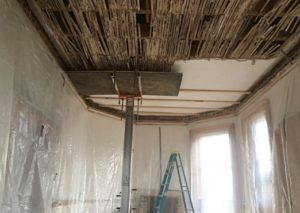Restoration Blog
2018 Ceiling Plaster Restoration
In 1809 the original lime plaster was started in the house to give Jefferson a more finished interior when he started using Poplar Forest. Unfortunately the work was not completed for several years. The discovery of many pieces of original wall plaster show that this lime material had brick dust added to strengthen its composition, an old trick going back to the Romans. The ceiling plaster, on the other hand, had animal hair added to help make it secure to the wooden lath strips nailed onto the bottom of the ceiling joists.
In 2018 our restoration team embarked on the process of plastering the ceilings in the same manner as Jefferson’s workmen with similar materials. Traditional lime putty, mixed with sand, is applied to hand-split oak lath strips nailed to the underside of the ceiling joists. In this three-coat process, the first “scratch” coat is applied to the lath, and what is pushed between the gaps in the lath forms the “key” that dries and holds the plaster in place. The second “leveling” or “brown” coat is then applied to the first coat, whose scratched surface provides places to bond the two coats together. The final “white” coat is almost all lime with finer sand and forms the finished surface.
The new materials: the lime putty made from burned limestone, the hand-split oak lath and the goat hair, come from England, where traditional lime plastering is still practiced. Two English plasterers living in the U.S. applied the three coats of lime plaster in the same manner as the original workers hired by Jefferson.
